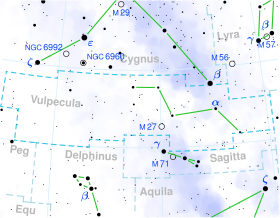Star in the constellation Vulpecula
15 Vulpeculae is a variable star in the northern constellation of Vulpecula , located approximately 243 light years away based on parallax. It has the variable star designation NT Vulpeculae ; 15 Vulpeculae is the Flamsteed designation . It is visible to the naked eye as a faint, white-hued star with a typical apparent visual magnitude of 4.66. This object is moving closer to the Earth with a heliocentric radial velocity of −26 km/s.
An ultraviolet band light curve for NT Vulpeculae, adapted from Kuvshinov et al. (1976) This is an Am star with a stellar classification of A4 IIIm, matching an evolved A-type giant star . However, Gray & Garrison (1989) found a class of kA5hA7mA7 (IV–V), which matches a blend of subgiant and main sequence luminosity classes with the K-line (kA5) of an A5 star and the hydrogen (hA7) and metal (mA7) absorption lines of an A7 star. It is an Alpha Canum Venaticorum -type variable with magnitude ranging from 4.62 down to 4.67 over a period of 14 days. The star is radiating 60 times the Sun's luminosity from its photosphere at an effective temperature of 8,084 K.
References
^ Brown, A. G. A. ; et al. (Gaia collaboration) (2021). "Gaia Early Data Release 3: Summary of the contents and survey properties" . Astronomy & Astrophysics 649 : A1. arXiv :2012.01533 . Bibcode :2021A&A...649A...1G . doi :10.1051/0004-6361/202039657 . S2CID 227254300 .doi :10.1051/0004-6361/202039657e ). Gaia EDR3 record for this source at VizieR .
^ Anderson, E.; Francis, Ch. (2012). "XHIP: An extended hipparcos compilation". Astronomy Letters . 38 (5): 331. arXiv :1108.4971 . Bibcode :2012AstL...38..331A . doi :10.1134/S1063773712050015 . S2CID 119257644 . Vizier catalog entry
^ Samus, N. N.; Durlevich, O. V.; et al. (2009). "VizieR Online Data Catalog: General Catalogue of Variable Stars (Samus+ 2007-2013)". VizieR On-line Data Catalog: B/GCVS. Originally Published in: 2009yCat....102025S . 1 . Bibcode :2009yCat....102025S .
^ Çay, İpek H.; Teker Yelkenci, Aysegul; Adelman, Saul J. (May 2016). "Elemental Abundance Analyses with DAO Spectrograms. XXXIX. The Am Stars 2 UMa and 15 Vul". Publications of the Astronomical Society of the Pacific . 128 (963): 054201. Bibcode :2016PASP..128e4201C . doi :10.1088/1538-3873/128/963/054201 . S2CID 123542297 .
^ Mermilliod, J. C. (2006). "VizieR Online Data Catalog: Homogeneous Means in the UBV System (Mermilliod 1991)". VizieR On-line Data Catalog: II/168. Originally Published in: Institut d'Astronomie . 2168 . Bibcode :2006yCat.2168....0M . Vizier catalog entry
^ Gontcharov, G. A. (2006). "Pulkovo Compilation of Radial Velocities for 35 495 Hipparcos stars in a common system". Astronomy Letters . 32 (11): 759–771. arXiv :1606.08053 . Bibcode :2006AstL...32..759G . doi :10.1134/S1063773706110065 . S2CID 119231169 .
^ McDonald, I.; Zijlstra, A. A.; Boyer, M. L. (2012). "Fundamental parameters and infrared excesses of Hipparcos stars" . Monthly Notices of the Royal Astronomical Society . 427 (1): 343–357. arXiv :1208.2037 . Bibcode :2012MNRAS.427..343M . doi :10.1111/j.1365-2966.2012.21873.x . S2CID 118665352 . Vizier catalog entry
Glebocki, R.; Gnacinski, P. (2005). "VizieR Online Data Catalog: Catalog of Stellar Rotational Velocities (Glebocki+ 2005)". VizieR On-line Data Catalog: III/244. Originally Published in: 2005csss...13..571G; 2005yCat.3244....0G . 3244 . Bibcode :2005yCat.3244....0G . Vizier catalog entry
"15 Vul" . SIMBAD Centre de données astronomiques de Strasbourg . Retrieved 2018-03-15.Kuvshinov, V. M.; Hildebrandt, G.; Schoeneich, W. (January 1976). "Photoelektrische Untersuchungen des Magnetfeldes und der Helligkeit der Am-Sterne 15 VUL und 68 Tau" . Astronomische Nachrichten . 297 (4): 181–188. Bibcode :1976AN....297..181K . doi :10.1002/asna.19762970405 . Retrieved 26 May 2022.
Categories :
Text is available under the Creative Commons Attribution-ShareAlike License. Additional terms may apply.
**DISCLAIMER** We are not affiliated with Wikipedia, and Cloudflare.
The information presented on this site is for general informational purposes only and does not constitute medical advice.
You should always have a personal consultation with a healthcare professional before making changes to your diet, medication, or exercise routine.
AI helps with the correspondence in our chat.
We participate in an affiliate program. If you buy something through a link, we may earn a commission 💕
↑

